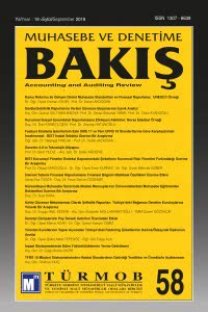EKONOMİK KATMA DEĞER VE BALANCED SCORECARD YAKLAŞIMLARININ ENTEGRASYONU
Bu çalışmada, önemli ve yaygın olarak kullanılan bir finansal performans değerlendirme ölçütü olan ekonomikkatma değer EVA ile Robert Kaplan ve David Norton tarafından 1992 yılında geliştirilen balanced scorecard BSC arasındaki potansiyel entegrasyon olanağı tartışılmaktadır. Öncelikle, her iki kavram hakkında bilgi verilmekte ve ekonomik katma değer ile balanced scorecard’ın avantajları ve kısıtları tartışılmaktadır. Sonrasında,EVA ile BSC arasında ilişki çerçevesinde iki yaklaşımın entegrasyonu anlatılmaktadır. Çalışmanın sonunda ise,elde edilen sonuçlar tartışılmaktadır
Anahtar Kelimeler:
Ekonomik Katma Değer, Balanced Scorecard, Performans Ölçme, Performans Değerlendirme.
In this study, a potential integration possibility between a popular financial performance evaluation indicator[economic value added EVA ] and a strategic management tool developed by Robert Kaplan and David Norton in 1992 [balanced scorecard BSC ] is discussed. Firstly, relevant literature is surveyed and the advantages&limitations of these two approaches are compared. Later on, according to a potential relationship betweenEVA and BSC, the integration of the two approaches is explained. Finally, the result of the study is presented
___
- Banker, R. D., G. Potter and D. Srinivasan. “An Empirical Investigation of An Incentive Plan That Includes Non- financial Performance Measures”, The Accounting Review, January 2000.
- Bontis, N., N. C. Dragonetti, K. Jacobsen and G. Roos, “The Knowledge Toolbox: A Review of The Tools Ava- ilable To Measure and Manage Intangible Resources”, European Management Journal, Vol. 17, No. 4, 1999.
- Bourguignon, A., V. Malleret and H. Norreklit, “The American Balanced Scorecard versus The French Table au de Bord: the ideological dimension”, Management Accounting Research, 15, 2004.
- Brewer, C. P., G. Chandra and C. A. Hock, “Economic Value Added (EVA): Its Uses and Limitations”, SAM Ad- vanced Management Journal, Spring, 1999.
- Ehrbar, Al, EVA: The Real Key to Creating Wealth, John Wiley & Sons, New York, 1998.
- Epstein, M. and J. F. Manzoni, “Implementing Corporate Strategy: from tableaux de bord to balance scorecards”, European Management Journal, April, 1998.
- Ercan, M. K. ve A. Üreten, Firma Değerinin Tespiti ve Yönetimi, Gazi Büro Kitabevi, Ankara, 2000.
- Ercan, M. K., M. B. Öztürk ve K. Demirgüneş, Değere Dayalı Yönetim ve Entellektüel Sermaye, Gazi Kita- bevi, Ankara, 2003.
- Fletcher, H. D. and D. B. Smith, “Managing for Value: Developing A Performance Measurement System Inter- prating Economic Value Added and The Balanced Scorecard in Strategic Planning”, Journal of Business Stra- tegies, Vol. 21, No. 1, 2004.
- Ittner, C. D., D. F. Larcker and M. V. Rajan, “The Choice of Performance Measures in Annual Bonus Contracts”, The Accounting Review, April, 1997.
- Kaplan, R. S. and D. P. Norton, “Using The Balanced Scorecard as A Strategic Management System”, Harvard Business Review, January-February, 1996.
- Kudla, R. J. and D. A. Arende, “Making EVA Work”, Corporate Finance, Fall, 2000.
- Lawrie, Gavin, “Combining EVA with Balanced Scorecard to Improve Strategic Focus and Alignment”, 2GC Li- mited, Discussion Paper, January, 2001.
- Martin, J. D., J. W. Petty, Value Based Management: The Corporate Response to The Shareholder Revoluti- on, Harvard Business School Press, Boston, 2000.
- O’Brien, David J., “The Value of Knowledge Management”, Project 32932, June, 2002.
- Otley, David, “Performance Management: a framework for management control systems research”, Manage- ment Accounting Research, 10, 1999.
- Rodov, I. and P. Leliaert, “FiMIAM: Financial Method of Intangible Assets Measurement”, Journal of Intellec- tual Capital, Vol. 3, No. 3, 2002.
- Stewart, G. B., “EVA: fact and fantasy”, Journal of Applied Corporate Finance, 7, 1990.
- Young, S. D. and S. O’Byrne, E VA and Value Based Management: A Practical Guide to Implementation, McGraw Hill, New York, 2001
- ISSN: 1307-6639
- Yayın Aralığı: Yılda 3 Sayı
- Başlangıç: 2000
- Yayıncı: TÜRMOB
Sayıdaki Diğer Makaleler
Yıldırım Beyazıt ÖNAL, Serkan Yılmaz KANDIR, Erdinç KARADENİZ
Ercan BAYAZITLI, Hilmi Erdoğan YAYLA, Eymen GÜREL
AVRUPA BİRLİĞİ’NE GİRİŞ SÜRECİNİN TÜRKİYE’DEKİ MUHASEBE EĞİTİMİNE ETKİLERİ
EKONOMİK KATMA DEĞER VE BALANCED SCORECARD YAKLAŞIMLARININ ENTEGRASYONU
Haluk BENGÜ, Kartal DEMİRGÜNEŞ
BASEL II STANDARTLARI VE KOBİ’LERDE KURUMSAL YÖNETİŞİM
ŞİRKET BİRLEŞMELERİNİN SONUÇLARI: BAŞARI VE BAŞARISIZLIK GÖSTERGELERİ, DEĞERLENDİRİLMESİ
